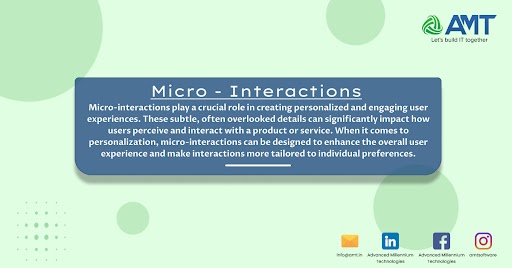Micro-interactions play a crucial role in creating personalized and engaging user experiences. These subtle, often overlooked details can significantly impact how users perceive and interact with a product or service. When it comes to personalization, micro-interactions can be designed to enhance the overall user experience and make interactions more tailored to individual preferences. Here are some ways micro-interactions can be used for personalization:
- Customized Feedback:
- Provide personalized feedback messages based on user actions or preferences.
- Use the user’s name in feedback messages to create a more personal connection.
- Dynamic Content Updates:
- Use micro-interactions to smoothly update content based on user preferences or behavior.
- Highlight personalized recommendations or content suggestions through subtle animations or transitions.
- Adaptive UI Elements:
- Customize the appearance of UI elements based on user preferences.
- Allow users to choose their preferred color schemes, themes, or layouts, and use micro-interactions to smoothly apply these changes.
- Personalized Notifications:
- Tailor notifications based on user preferences or behavior.
- Allow users to choose the types of notifications they want to receive and use micro-interactions to make these alerts more visually appealing.
- Interactive Personalization Settings:
- Create interactive and visually appealing settings panels for users to customize their experience.
- Use micro-interactions to provide real-time previews of how changes in settings will impact the user interface.
- Animated Personalization Onboarding:
- Use micro-interactions in onboarding processes to guide users through personalization steps.
- Provide animated tutorials or walkthroughs that demonstrate how to personalize their experience.
- Gestural Personalization:
- Implement gestures or swiping actions that users can customize for specific functionalities.
- Use micro-interactions to provide visual feedback when users perform personalized gestures.
- Gamified Personalization:
- Introduce gamification elements to encourage users to personalize their profiles.
- Reward users with micro-interactions such as animations or sound effects when they achieve personalization milestones.
- Personalized Loading Screens:
- Customize loading screens with user-specific content or recommendations.
- Use micro-interactions to entertain users during loading times with animations or interactive elements.
- Contextual Micro-Interactions:
- Implement micro-interactions that adapt to the context of the user’s actions.
- For example, if a user frequently accesses certain features, provide quick access shortcuts through contextual micro-interactions.
Remember, the key is to strike a balance between personalization and simplicity. Micro-interactions should enhance the user experience without overwhelming the user with too many options or unnecessary animations. Additionally, it’s essential to respect user privacy and obtain explicit consent before collecting and using personalization data.
Watch this space for more updates on the latest trends in Technology.
